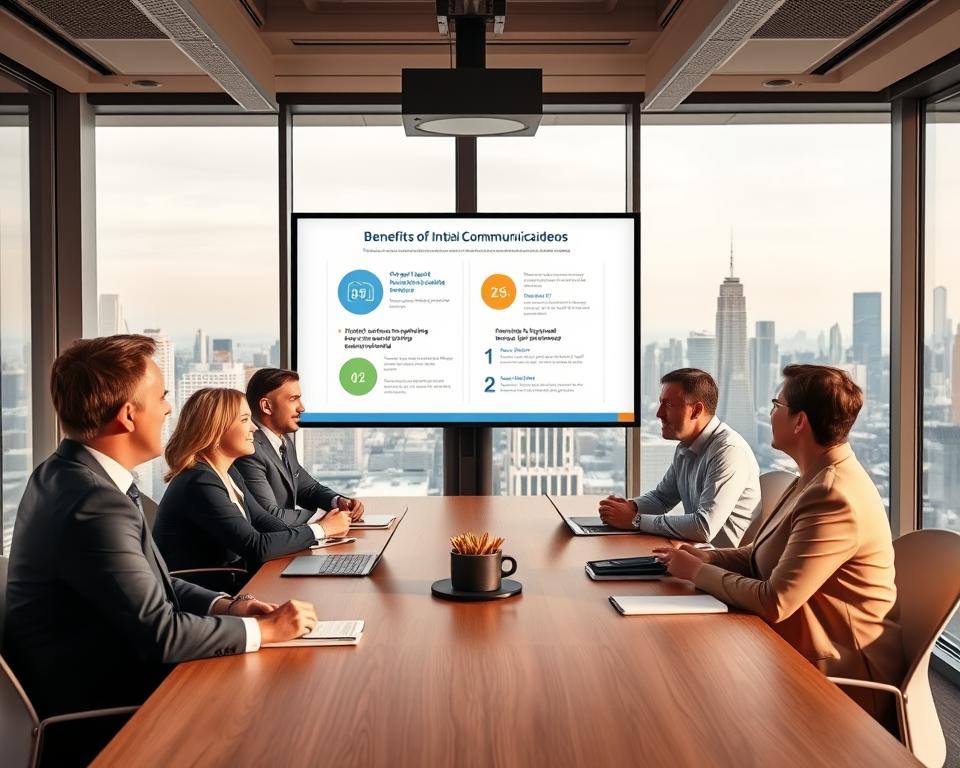
Boost Business Success with Internal Communications Videos
Did you know 25% of employees leave within a year because of bad communication? This shows how important it is for companies to talk to their teams better. Today, corporate communication videos are a must, not just a nice-to-have. With 65% of people learning better through visuals, videos help make complex ideas simple.
Imagine a tool that keeps 97% of viewers informed about company goals and reduces confusion. That’s what internal communications videos can do.
These videos help in many ways, like sharing updates and training new employees. They make abstract policies easy to understand by turning them into stories. Companies like Google and Bolt use videos to show their culture and keep their teams loyal. Videos are great for building trust and making things clear, something text can’t do as well.
Key Takeaways
- Video reduces employee turnover by addressing communication gaps.
- Visual learning styles make internal communications videos 97% effective for clarity.
- Corporate communication videos simplify remote team alignment and culture-building.
- Employee engagement spikes when leaders use video for real-time messaging.
- Short training videos boost onboarding retention by 69%, as seen in industry case studies.
As workplaces get more spread out, companies in the UK are turning to video to stay connected. This part looks at how and why your company can use video to overcome communication challenges and get ahead.
What Are Internal Communications Videos and Why They Matter
Internal communications videos are digital tools that help connect employees with company news, training, and culture. They are different from external marketing because they talk directly to employees. This helps in making things clear and building a strong connection.

Defining Modern Corporate Communication
Today’s business communication videos change how we talk at work. They match how we learn best, with 65% of us being visual learners. Videos use pictures, sound, and movement to make messages stick in our minds.
This way, employees can quickly understand company policies, values, and goals. It’s much better than just reading about it.
The Evolution of Employee Messaging
- 1980s: Memos and printed manuals
- 2000s: Email newsletters and intranet posts
- 2020s: Video-centric platforms dominate
Now, big UK companies like Barclays and Tesco use videos for training and updates. This shows how important videos are in today’s work world.
Why Visual Content Outperforms Text-Only Communication
| Comparison | Text | Video |
|---|---|---|
| Engagement | Low | 75% higher (Forrester) |
| Retention | Short-term | Longer memory retention |
| Processing Speed | Slower | 60,000x faster (Neuroscience research) |
Video is better because it uses our brain’s natural way of learning. This makes corporate communication videos perfect for training, sharing policies, and building company culture. People remember 95% of what they see in a video, compared to just 10% of what they read.
The Business Case for Internal Communications Videos
Internal communications videos are changing how companies talk to their employees. Over 48% of UK workers like videos more than emails. This makes videos a smart way to keep everyone engaged and clear on what’s happening.
By using short, visual content instead of long reports, teams save a lot of time. They also remember messages better.
- Time savings: Video updates are quick and to the point, cutting down on email back-and-forth.
- Cost efficiency: Using mobile phones to make videos can save money on production costs.
- Engagement: Videos tell stories in a way that keeps employees informed and on track with company goals.
| Traditional Methods | Internal Communications Videos |
|---|---|
| Text-heavy emails | Visual and auditory engagement |
| Low retention rates | Up to 95% retention of key messages |
| Time-consuming to distribute | Instant sharing across all departments |

A 2023 study by the CIPD found companies using video saw a 30% drop in errors due to miscommunication. For example, a UK retail giant cut training time by 50% by using onboarding videos instead of manuals. Employees can watch videos whenever they want, which helps them stay productive without being overwhelmed by emails.
Business communication videos also help build a strong company culture. A UK tech firm saw a 25% increase in employee satisfaction after starting monthly CEO video updates. When used wisely, these tools are not just a trend. They are a valuable investment in team unity and work efficiency.
Types of Internal Communications Videos That Drive Engagement
Effective internal videos are made to fit specific workplace needs. They come in four main types, each designed to engage different departments and team sizes:

Executive Updates and Company News Videos
Leaders share important news through company news update videos. For example, a UK retailer’s quarterly videos boosted staff engagement by 28%. They highlighted regional store successes. Tools like Synthesia make creating these videos easy, helping teams stay informed during fast changes.
Employee Training and Development Content
- Onboarding videos cut ramp-up time by 40% compared to text manuals.
- Microlearning videos (3–5 minutes) improve knowledge retention by 30%.
Manufacturing companies like JCB use videos to teach safety rules worldwide.
Culture-Building and Team Recognition Videos
Storytelling connects people: 76% of UK employees like culture-focused employee engagement videos. A London fintech firm saw a 15% drop in turnover after starting “Team Spotlight” episodes every month.
Crisis Communication and Change Management
Video messages from leaders help keep morale up during tough times. A tech startup in Edinburgh used videos to explain a restructuring, cutting attrition by 18% during a pandemic shift.
Creating Impactful Internal Training Videos on Any Budget
Making great internal training videos doesn’t need a big budget. Whether it’s for new hires or following rules, there are ways to be creative without spending too much. Let’s look at how to make a big impact without breaking the bank.

DIY vs. Professional Production Considerations
First, check what your team can do. For simple staff training video production, tools like Loom or Storykit are great. But for complex stuff, like safety rules, you might need a pro. Here’s what to think about:
- DIY: Good for short, easy content. Use phones and free software to save money.
- Professional: Best for important training that needs to be perfect. Look for agencies with different prices.
Equipment Essentials for In-House Creation
Good quality starts with basic stuff. Make sure you have these:
- Cameras: Smartphones are okay for simple videos. For better quality, get a mid-range DSLR or a ring light for webcams.
- Editing software: Free tools like Adobe Premiere Rush or Vyond can make videos without costing anything.
- Sound: A portable mic helps get rid of background noise, making your internal training videos clearer.
Cost-Effective Strategies for High-Quality Results
Use content in different ways to save money. Record one session and use it in many ways, like breaking a safety video into shorter parts. The IRS saved 83% by doing this. Here are some tips:
- Make seasonal content all at once to save time.
- Use real employee stories to add truth without spending more.
Even with a small budget, you can make staff training video production that really works. With the right tools and plan, even tight budgets can make engaging videos that stick with your team.
Optimizing Video Content for Your Company Intranet
Creating great video content for intranet sites means making it easy to use. Think about how internal communications videos work on phones—57% of views happen on mobiles. Use tools like Sociabble’s SEV for fast playback, even on slow networks. It also offers AI summaries and supports 50+ languages, helping global teams connect better.

Embedding videos in newsletters? ContactMonkey makes it simple: just copy the URL, insert it into your email, and add a play icon. Make sure videos play smoothly on all devices and browsers. Add subtitles for everyone to understand, and use keywords like “HR updates” to help people find them.
- Use short, 2-5 minute clips for attention retention
- Include closed captions for non-native speakers
- Link videos to relevant policies or training modules
Keep an eye on how people watch your videos with analytics tools. Change your content based on what people like. For instance, a UK manufacturing firm saw a 40% increase in training completion with video tutorials. Keep it simple and clear to make a big impact.
Measuring the Effectiveness of Your Internal Communications Videos
Tracking the impact of corporate communication videos shows if they’re working. With 70% of internal teams looking for ROI proof, it’s key to use data. Focus on metrics that show more than just how many views you get.
Key Performance Indicators to Track
Here are the metrics to check for success:
- Completion rates: How many employees watch videos all the way through?
- Watch time: Longer watch times mean more engagement.
- Action triggers: Did videos lead to actions, like signing up for training?

Gathering Meaningful Employee Feedback
Use surveys and focus groups to get deeper insights. Post-video quizzes on platforms like ContactMonkey show how well employees remember what they learned. Employee testimonials share how employee engagement videos help in real life. YouTube’s analytics show shares and comments, showing interest.
Adjusting Strategy Based on Analytics
A UK retail company improved its training video success by 40% after listening to feedback and changing their content. Use data to tweak topics, formats, and when to share them. Match metrics with business goals, like better productivity or faster onboarding, to show value.
“Effective measurement isn’t about perfection—it’s about progress.”
Keep checking analytics to find areas to improve. For example, if videos aren’t being watched to the end, they might be too long. Try making them shorter, adding subtitles, or breaking them into smaller parts.
Common Pitfalls in Business Communication Videos and How to Avoid Them
Effective business communication videos avoid common mistakes. These mistakes can lessen their impact. Many companies miss simple fixes that could make their corporate communication videos more engaging and clear.

| Pitfall | Solution | Example |
|---|---|---|
| Outdated distribution methods | Adopt cloud-based platforms instead of desk drops | UK firms maintained communication during lockdowns via cloud intranets |
| Ignoring audience needs | Segment content by department or role | A healthcare provider boosted engagement by targeting updates to specific teams |
| Overloading with data | Trim content to 3-5 key points per video | A manufacturing firm cut video length by 50% to improve retention |
- Avoid email distribution—use intranet platforms instead
- Incorporate storytelling to simplify complex messages
- Test videos with small teams before full release
Successful corporate communication videos focus on clarity. By learning from these tips, UK businesses can avoid mistakes. This way, they can strengthen connections with their employees.
Case Studies: Successful Staff Training Video Production in UK Companies
Companies across the UK are using videos to engage their employees. Banks and factories have seen big changes. Let’s look at how three UK companies improved their training.

Financial Services Sector Success Story
Guardian Group made regulatory updates easier with staff training video production. They used animations to explain complex policies. The Caribbean Development Bank also used videos to boost wellness program participation.
Both saw their training times cut in half. This shows how videos can make a big difference.
- Guardian reduced compliance errors by 25% after rolling out video-based modules.
- Caribbean Development Bank’s animated videos achieved 98% employee engagement in wellness program uptake.
Manufacturing Industry Implementation
Sage Appliances shortened onboarding by 30% with internal training videos. Their 26-minute video on barista training used whiteboard graphics and live demos. This reduced safety incidents by 20% in 15 UK sites.
Managers also noticed better retention of safety protocols.
Retail Business Transformation Through Video
Joules’ customer service team learned through video onboarding. Short clips showed real scenarios, cutting training time from 4 weeks to 2 weeks. Customer feedback scores went up 18% after staff watched videos on conflict resolution.
These examples show how video content can align teams and improve results. From animated guides to hands-on demos, the right staff training video production meets any challenge.
Future Trends in Corporate Communication Videos
Workplaces are changing, and so are the ways we connect. Corporate communication videos are moving into new areas. They’re going beyond old formats to bring in fresh ideas. Trends like personalized stories and AI tools are changing how we share ideas.

Now, videos can be interactive. Imagine training that lets you choose your path or company news update videos with polls. Personalization engines make sure each message is right for the viewer. “Video’s adaptability makes it a standout tool,” says a Forbes expert.
- AI streamlines production: Automated editing tools cut down on time, and voice-to-text features make subtitles fast.
- Mobile-first design focuses on short, vertical clips for smartphones, perfect for busy teams.
- Accessibility features like BSL overlays and AI-generated captions make videos inclusive easily.
Short videos (1–3 minutes) are now the norm for quick updates. Longer videos use chapter markers for easy navigation. Platforms like Teams and Slack now host video hubs, mixing formal and casual content.
Tomorrow’s corporate communication videos will mix technology and human touch. They’ll make messages clearer, faster, and more personal than ever.
Conclusion: Implementing Effective Internal Communications Videos for Long-Term Success
Internal communications videos and company news update videos are now a must. With 89% of businesses using video for customer outreach, it’s time for employees too. Visual storytelling helps teams understand each other better. Start with a simple video, like sharing goals or celebrating successes, to get everyone involved.
Studies show videos grab attention faster than text. Over 75% of employees like watching more than reading, and 90% of brain processing is visual. Use this to make messages that really connect. For example, animated videos can explain complex policies, and videos from employees can build trust. Add quizzes or polls to make viewers more active and engaged.
Start with a small test. Share a company news video in a team meeting and ask for feedback. Track how long people watch and if they click on links to improve your videos. Remember, keeping up a regular schedule is key. Update everyone monthly or quarterly to keep everyone on the same page. Use videos for training and onboarding to clear up confusion and save time.
Don’t worry about the cost. Tools like Canva or Loom make creating videos easy and affordable. Get your team involved in making videos to make them feel more connected. With 59% of executives preferring video, it’s clear the shift to visual communication is here. Start by picking one important message to share through video. Small steps today can create a workplace where everyone feels connected and informed.